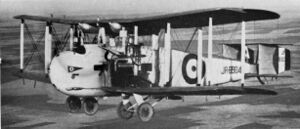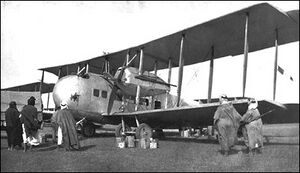Engineering:Vickers Vernon
| Vernon | |
|---|---|

| |
| Vernon of 70 Squadron RAF, powered by Rolls-Royce Eagle engines. | |
| Role | Transport |
| Manufacturer | Vickers |
| Introduction | 1921 |
| Retired | 1927 |
| Primary user | Royal Air Force |
| Number built | 55 |
| Developed from | Vickers Vimy Commercial |
The Vickers Vernon was a British biplane troop carrier[1] used by the Royal Air Force . It entered service in 1921 and was the first dedicated troop transport of the RAF.
The Vernon was a development of the Vickers Vimy Commercial, a passenger variant of the famous Vickers Vimy bomber, and was powered by twin Napier Lion engines or Rolls-Royce Eagle VIII engines.[1] 55 were built.
In February 1923, Vernons of Nos. 45 and 70 Squadrons RAF airlifted nearly 500 troops to Kirkuk, Iraq[2] after the civilian area of that town had been overrun by Kurdish forces. This was the first-ever[3] strategic airlift of troops.
Vernons of No. 45 Squadron had bomb racks and sights fitted.[4] In May 1924 the squadron was officially designated No. 45 (Bombing) Sqdn.[5]
Vernons were replaced by Vickers Victorias from 1927.
Variants
- Vernon Mk I
- military transport aircraft powered by two 360 hp (270 kW) V-12 Rolls-Royce Eagle VIII piston engines.
- Vernon Mk II
- military transport aircraft powered by two 450 hp (340 kW) W-12 Napier Lion II piston engines.
- Vernon Mk III
- military transport aircraft powered by two high compression 525 hp (391 kW) W-12 Napier Lion III piston engines.
Operators
 United Kingdom
United Kingdom
- Royal Air Force
- No. 45 Squadron RAF
- No. 70 Squadron RAF
Specifications (Vernon)
Data from Aircraft of the Royal Air Force[6]
General characteristics
- Crew: 3
- Capacity: 11 passengers
- Length: 42 ft 8 in (13.00 m)
- Wingspan: 68 ft 1 in (20.75 m)
- Height: 13 ft 3 in (4.04 m)
- Wing area: 1,330 sq ft (124 m2)
- Empty weight: 7,981 lb (3,620 kg)
- Gross weight: 12,544 lb (5,690 kg)
- Powerplant: 2 × Napier Lion water-cooled 12-cylinder broad-arrow engine, 450 hp (340 kW) each
Performance
- Maximum speed: 118 mph (190 km/h, 103 kn) at ground level[7]
- Cruise speed: 75 mph (121 km/h, 65 kn)
- Range: 320 mi (510 km, 280 nmi) at 80 mph (70 kn; 130 km/h)[7]
- Service ceiling: 11,700 ft (3,600 m) [7]
- Time to altitude: 13 min 30 s to 6,000 ft (1,800 m)
Armament
- Bombs: Provision for bombs
See also
Related development
Related lists
- List of aircraft of the Royal Air Force
References
- ↑ 1.0 1.1 Thetford 1962, p. 443
- ↑ Wragg 1986, p. 13
- ↑ Johnson & Cozens 1984, p. 38
- ↑ Embry 1976, p. 34
- ↑ Moyes 1964, p. 67
- ↑ Thetford 1957, pp. 420–421
- ↑ 7.0 7.1 7.2 Andrews & Morgan 1988, p. 104
- Andrews, E. N.; Morgan, E. B. (1988). Vickers Aircraft Since 1908 (2nd ed.). London: Putnam. ISBN 0-85177-815-1.
- Embry, Basil (1976). Mission Completed. London: White Lion. ISBN 0-7274-0260-9.
- Johnson, Brian; Cozens, H. I. (1984). Bombers The Weapon of Total War. London: Methuen. ISBN 0-423-00630-4.
- Moyes, Philip (1964). Bomber Squadrons of the R.A.F. and Their Aircraft. London: MacDonald. OCLC 796778515.
- Thetford, Owen (1957). Aircraft of the Royal Air Force 1918–57 (1st ed.). London: Putnam. OCLC 936602559.
- Thetford, Owen (1962). Aircraft of the Royal Air Force since 1918. London: Putnam. OCLC 213505944.
- Wragg, David (1986). Airlift A History of Military Air Transport. Shrewsbury: Airlife. ISBN 0-906393-61-2. https://archive.org/details/airlifthistoryof0000wrag.
 |


